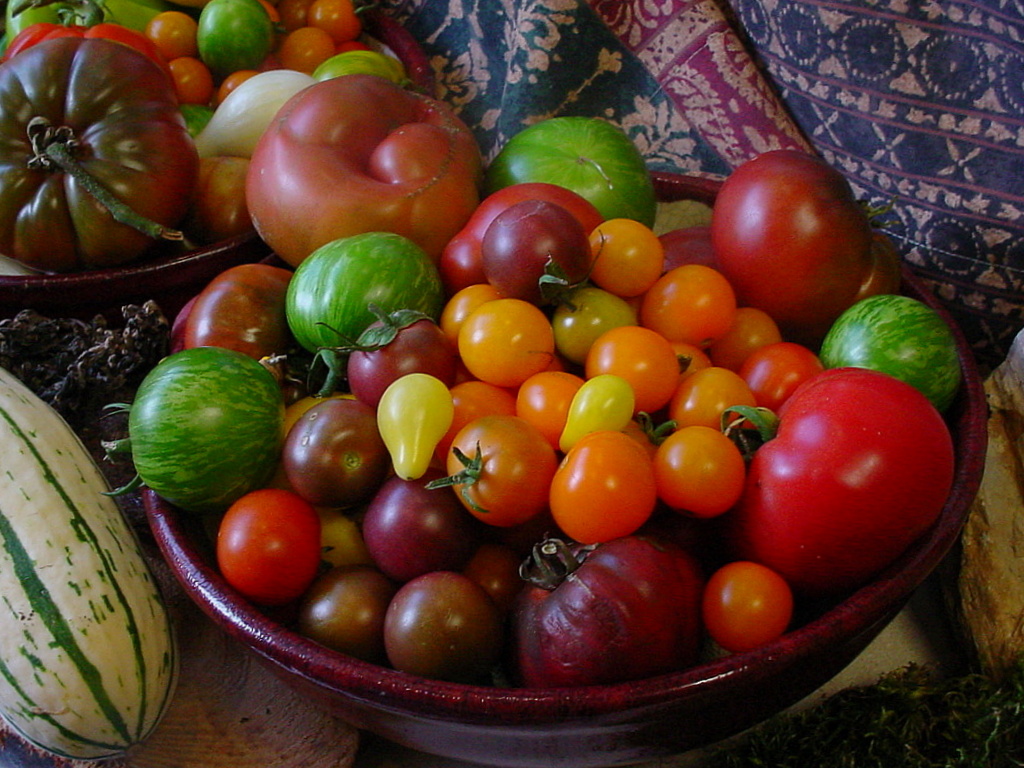 Plant Biology
Plant Biology
Bringing the flavor back to modern tomatoes
Wondering why modern tomatoes are often so tasteless? New insights on their DNA offer a roadmap to bring back their tasty flavor.

While many people remember the wonderful flavor of a garden-grown heirloom tomato, this flavor is not found in modern commercial tomatoes. Modern tomato breeding has focused on disease resistance, yield, shelf-life and firmness for shipping. While these traits are essential for large scale year-round production of tomatoes, breeding for these characteristics without also selecting for good tomato flavor has resulted in the loss of flavor. Unfortunately, good flavor is a difficult trait to define or quantify, making the breeder's ability to restore flavor to modern tomatoes difficult.
Tomato flavor is a combination of sugars, acids and aroma compounds. High levels of sugars and acids are important for good flavor, but the aroma compounds are the basis for the unique tomato smell and flavor. Over 400 aroma compounds are found in tomatoes, with at least twenty of these contributing to flavor. This is in contrast to some fruits where only one or two aroma compounds account for much of the flavor. Tomato aroma compounds are biosynthesized from many different biochemical pathways, originating from amino acid, lipid and carotenoid precursors. This complexity makes the task of restoring flavor extremely difficult. In order to understand what consumers prefer in a good tasting tomato, taste panels were conducted at the University of Florida. About 75 panelists were asked to rate over 100 tomato varieties on overall liking, sweetness, sourness and other attributes of the tomatoes. These same tomato varieties were analyzed for the biochemicals that make up tomato flavor, including sugars, acids and aroma compounds. This allowed the researchers to determine the most important contributors, both negative and positive, to tomato flavor.
Unfortunately, these methods for determining flavor acceptability of new tomato varieties are not practical for tomato breeders. It is simply too time consuming and expensive. The need for a simpler method of determining flavor quality of a new variety was needed. Researchers at the University of Florida, the Chinese Academy of Agricultural Sciences, Consejo Superior de Investigaciones Científicas-Universitat Politècnica de València, Spain and the Hebrew University of Jerusalem have sequenced the genomes of 398 tomato varieties, including modern, heirloom and wild South American tomato varieties. These varieties were also profiled for flavor compounds including sugars, acids and aroma compounds. Using statistical analysis the researchers were able to identify changes in areas of the genome that were associated with specific flavor compounds. Using this information, breeders can select for improved flavor by looking for specific changes in the DNA sequence. By crossing a modern tomato variety with a good tasting heirloom variety, then through multiple backcrossing and selection for good flavor from the heirloom parent and the desired traits from the modern parent, a modern variety with restored flavor can be obtained. Examining the DNA sequence during the breeding process is much simpler than analyzing the flavor by taste panels or looking at flavor biochemical levels. Now breeders can look at the flavor attributes of a seedling in the same way they look for disease resistance. If the seedling does not have the DNA sequences indicative of good flavor that seedling can be discarded, saving time and money. If a seedling has the DNA sequences for potential good flavor, it can be grown to maturity and good flavor confirmed by tasting and biochemical analyses.
Determining the genetics and biochemistry of excellent tomato flavor has been the result of decades of work for many scientists. Now plant breeders can use the knowledge gained from this research to give consumers a great tasting tomato. The same methods are now being used in other fruit crops to understand the biochemisty and genetics of improved flavor. Better tasting fruits and vegetables will encourage consumers to eat more healthy foods and enjoy better health.
Original Article:
Tieman D, Zhu G, Resende M, Lin T, Nguyen C, Bies D, Rambla J, Beltran K, Taylor M, Zhang B, Ikeda H, Liu Z, Fisher J, Zemach I, Monforte A, Zamir D, Granell A, Kirst M, Huang S, Klee H. A chemical genetic roadmap to improved tomato flavor. Science. 2017;355(6323):391-394. doi:10.1126/science.aal1556.Next read: The Poisoned Oasis: Neonicotinoid Spillover Harms Bees Near Corn by Nadia Tsvetkov , Amro Zayed
Edited by:
Massimo Caine , Founder and Director
We thought you might like
A new code for a new life
May 26, 2016 in Maths, Physics & Chemistry | 3.5 min read by Jordan CostafrolazA novel treatment for inherited blinding eye diseases
Feb 1, 2018 in Health & Physiology | 3.5 min read by Tara MooreGMOs are not a human invention: sweet potato is a naturally transgenic food crop
Jul 6, 2015 in Plant Biology | 3 min read by Tina KyndtCloudy days cost yield until scientists hacked photosynthesis
Feb 2, 2017 in Plant Biology | 3.5 min read by Stephen Long , Katarzyna Głowacka , Johannes KromdijkMore from Plant Biology
Unravelling the Secrets of Pine Roots: A Tale of Nutrition and Adaptation
Oct 20, 2023 in Plant Biology | 3.5 min read by Rafael Cañas , Francisco OrtigosaStressful memories help plants resist caterpillars
Oct 2, 2023 in Plant Biology | 3.5 min read by Samuel Wilkinson , Adam Hannan Parker , Jurriaan TonDecoding the genome of a jackfruit that grows all year round
Sep 6, 2023 in Plant Biology | 3.5 min read by Tofazzal IslamLife after logging: the tale of recovering tropical forests
Aug 21, 2023 in Plant Biology | 3.5 min read by Maria Mills , Terhi RiuttaEditor's picks
Trending now
Popular topics


